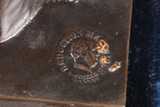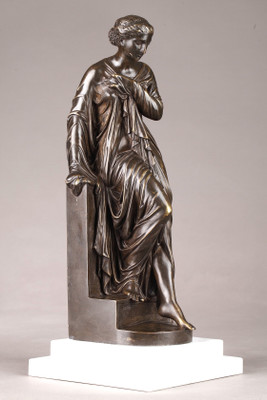A bronze sculpture with a brown patina depicting Pandora, her hair styled and draped in classical attire, holding the box given to her by Zeus, from which, according to legend, all the evils of humanity escaped. Signed in relief on the base: "Ene AIZELIN Fit 1864" and "F. BARBEDIENNE FONDEUR". Stamped "Réduction mécanique A. Collas Breveté". Public exhibition label: F. Barbedienne, 30 Boulevard Poissonnière, Paris. Numbered 4486. The sculpture is presented on its original velvet plinth with label.
Eugène Antoine Aizelin (1821-1902) was a student of Ramey and Dumont at the École des Beaux-Arts and made his debut at the Salon in 1852 with a "Sappho", a plaster cast which he exhibited in bronze the following year. Among his principal works are: "Nissya at her Bath" (3rd medal, Salon of 1859), the same subject in marble (2nd medal, Salon of 1861), "Psyche," 1863 (Quimper Museum), "The Child and the Hourglass," 1864, "A Suppliant," 1865 (Montpellier Museum), "Orpheus Descending into the Underworld," 1870 (Reims Museum), "The Idyll" (Louvre Courtyard), "The Departure from the Church," 1875, "Defeated Amazon," 1876, "Pandora," "The Pastoral," 1876, "Marguerite," 1884, "Hagar and Ishmael," 1888 (Luxembourg Museum), "Judith" (Luxembourg Museum), "Saint Gregory and Saint Cyril" (Trinity), "Saint Genevieve and A bishop” (Saint-Roch), “Bailly and Madame de Sévigné” (Town Hall). He received a second medal in 1878 and a gold medal in 1889. Aizelin was appointed an officer of the Legion of Honour. 19th century, circa 1870
- Reference :
- 2270
- Availability :
- Sold
- Width :
- 16 (cm)
- Height :
- 47 (cm)
- Depth :
- 15 (cm)
- Identify Exists:
- False






















